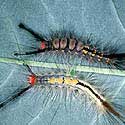Tussock Moth Caterpillars in Northcentral Florida
 By: John L. Foltz , Department of Entomology and Nematology, University
of Florida - IFAS
By: John L. Foltz , Department of Entomology and Nematology, University
of Florida - IFAS
Each spring there are reports about tussock moth caterpillars being abundant in northcentral Florida. Besides the annoying presence of numerous hairy caterpillars, many larvae spin their difficult-to-remove cocoons on outdoor furniture, stored boats, and the walls and soffits of our houses. Feeding by the caterpillars usually has little impact on oak trees, their preferred hosts, but wind-blown caterpillars may land on and defoliate small trees and shrubs around the yard.
Life Cycle
Hatch from the overwintering eggs starts in late February and early March, about the time that oak trees are beginning to produce new foliage. Caterpillars mature and disperse to spin cocoons in early April. Males emerge and fly to the wingless females from mid April into early May. The wingless female lays eggs on her cocoon and dies. Our most common species has just one generation per year. For the other two species there will be a second generation of caterpillars during the summer.
Identification
The most common of the three species we have in Florida is Orgyia detrita. Caterpillars of this species have a red head, two black "hair pencils" projecting forward like antennae, four dense tufts of hair on the back, and a single hair pencil projecting to the rear like a tail. Unique to this species are the orange-colored spots along the back and sides. Caterpillars of the whitemarked tussock moth, Orgyia leucostigma, also have a red head, three hair pencils and four tussocks; they are distinguished by their lighter body color and yellow spots. The rarely-encountered third species, Orgyia definita, has a yellow or tan head to go with its hair pencils and tussocks.
Recommendations
My recommendations for homeowners disturbed by tussock moth caterpillars:
- Any of the common foliar insecticides will effectively kill those caterpillars still feeding. Timing is critical, however. Caterpillar management needs to be done before the larvae are fully grown and have ceased feeding. Waiting until the larvae are dispersing to pupate is too late.
- People who want to minimize cocoons on their house should walk around it with a broom and sweep the climbing caterpillars into a pail of soapy water.
- Cocoons can be removed by slipping tweezers or a similar instrument between the cocoon and the wall. I recommend wearing a long-sleeved shirt while doing this, as the caterpillar hairs may irritate the skin on the forearm.
An interesting project for some would be to collect fresh cocoons in ventilated glass jars. Within 10 days there should be adult moths and several natural enemies. Parasitism often runs near 50%.
Pictures and additional information on tussock moths are also available on the Forest and Shade Tree Insects web site.


